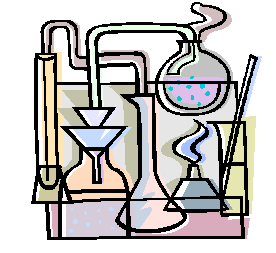Anatomy
& Physiology |
|||||||
|
|||||||
| Basic Chemistry - pp. 56-67 A knowledge of basic chemistry is important for understanding just about any area of biology from the function of cells to the behavior of organisms and the ecological relationships between organisms and their environment. Biology is about living things - organisms. All living organisms are made of chemicals. To understand biological substances and the changes that take place in living organisms you need a good knowledge of the underlying chemistry. We will build up a picture of the chemicals that make up living organisms by starting small and getting bigger. The starting point is atoms - the building blocks of all matter. We will then look at how these come together to make elements and compounds. Resources: Tutorial on Chemistry for Biology People - w/Problems , Atoms Atoms are basic components of the matter we are familiar with. Atoms are the smallest part of matter that have chemical properties characteristic of a particular chemical element. Most of the mass of an atom is due to the atomic nucleus. The nucleus consists of protons which have a positve electrical charge and neutrons which have no charge. This is a representation of a carbon atom. Previous Page Atomic number and atomic mass. The atomic number of an atom is the number of protons in the atom which, if the atom is neutral, equals the number of electrons. This is important because the number of electrons is related to the chemical properties of the atom. The atomic mass is the total mass of the electrons, protons, neutrons in the atom. Isotopes are atoms that have the same atomic number(number of protons) but differ in atomic mass. For instance most carbon has six protons and six neutrons and thus atomic mass of of approxiately 12. Some carbon atoms have an atomic mass of 13 so thus have six protons and seven neutrons. All isotopes of the same element have about the same chemical properites because the number pattern of electrons is the same. Electrons are small components which are surrounding the nucleus. Electron have a negative charge. An atom with no net electrical charge has the same number of electrons as protons. Electrons are restricted to certain energy levels "shells" and orbitals within those energy levels and these energy levels and orbitals fill in a regular pattern from the lowest energy level outward. IMPORTANT Electrons are important for several reasons: * Chemical bonds are formed when electrons are transfered or shared between atoms. * The arrangement of electrons in the atoms of an element help to determine the chemical properties of an element. For example when the outer most energy level of an atom is almost empty, the atoms of the element tend to give up electrons. A good example is sodium (Na). When the outermost energy level of an atom is almost (but not completely) full, the atoms of the the element tend to grab electrons from other atoms. A good example is chlorine (Cl). What happens if it is full? * Finally electrons can carry and store energy and this is important in understanding metabolism. Everytime a chemical reaction takes place, elecrons are shared or transferred between atoms and hence energy is shared or transferred. For example, in photosynthesis light energy is captured and stored by electrons. Then the electrons are used to make glucose, and other organic molecules which store the energy as potential energy in their chemical bonds. Compounds Elements form compounds. But simply mixing elements together does not make a compound. A chemical reaction is needed. Atoms of elements combine, but only in certain fixed ratios. The ratios are determined by the combining power of atoms. We called this the valence. For example: * carbon has a valence
of 4, which means each carbon atom can form 4 bonds Where does this number come from? The combining power is the number of electrons in an atom that can be used to form chemical bonds. When one atom bonds to another it is these available electrons which are involved, i.e. those in the outermost electron-containing energy level. Their arrangement is always changed by a chemical reaction unlike the electrons in the inner shells. Usually, when atoms react, they achieve a more stable electronic structure. The compounds that make up living organisms fall into two types: * Inorganic compounds, e.g. water (which exists as molecules) and salts (which contain ions such as potassium, calcium and chloride).
Organic compounds can be recognised from their formulae - they all contain the element carbon. The only inorganic compounds that contain carbon are, for examples, (CO2), (CO), (CO3(2-)) , (HCO3-), and others. |


